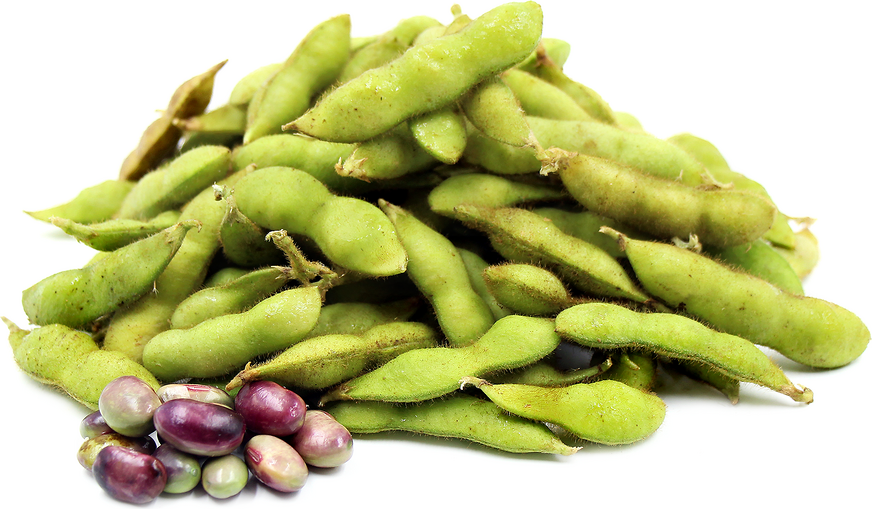


Black Soybeans
Estimated Inventory, lb : 0
Description/Taste
Black soybeans grow on plants which can reach two meters tall and are densely covered in large hairy leaves. It blooms in the spring with white and purple flowers which are also edible. Additionally the broad and slightly flattened pods are covered in a fine layer of coarse hairs making their texture unpalatable. Pods may be green, yellow or brown at harvest. The interior soybeans are jet black and mostly round, averaging four per pod. They have an excellent buttery texture and offer a nutty and richer, sweeter flavor than yellow soybeans.
Seasons/Availability
Fresh Black soybeans are available in the summer and fall months.
Current Facts
Black soybeans are an annual legume botanically known as part of Glycine max and a member of the Fabaceae family. They are considered a shelling bean, meaning they are grown primarily for their edible seed inside. Most often the pod is not eaten, because it too fibrous to consume. Black soybeans are often found in the dried, canned, and fermented form when out of season. They are easier to digest and considered to be much tastier than the common yellow soybean. All soybeans must be cooked with wet heat prior to consumption and in their raw form are actually considered toxic to humans and other animals that have single chambered stomachs.
Nutritional Value
Black soybeans are rich in nutritional content containing dietary fiber, iron, calcium, B vitamins, zinc, lecithin, phosphorous, magnesium and are over 35 percent protein by weight. Additionally soybeans such as the Black soybean are the only legume which contain all nine essential amino acids. Commercially processed soybeans will lose some of this nutritional content so for utmost nutritional benefit be sure to use fresh soybeans.
Applications
Black soybeans must be shelled and their edible beans removed then cooked prior to consumption. The beans should first be soaked overnight then on average will take approximately 90 minutes to cook to an al dente state. Prepared beans can be seasoned with salt and eaten as is or utilized in a number of preparations. Cooked beans can be added to green, grain and bean salads or incorporated into a dip along with other chopped vegetables and herbs. They can also be cooked down further and used to make fillings for lettuce wraps and dumplings or formed into patties for burgers. Cooked Black soybeans can be pureed and added to soups, sauces, stews and hummus. Complimentary flavors include ginger, garlic, soy sauce, pork, bitter greens, daikon, red onion, maple syrup, toasted sesame oil, autumn squash, cilantro, mushrooms, cumin, ghee, sesame seed and rice wine. To store keep Black soybeans refrigerated and use within a weeks time or beans can be dried, canned or fermented and saved for later use.
Ethnic/Cultural Info
In China soybeans such as Black soybean have long been an important cullinary ingredient in both fresh prepared forms and processed. Fermented Black soybeans or douchi are one of the oldest known preparations of soybean dating back to 165 BC where evidence of them have been found in a tomb of the Han dynasty at Han Tomb No. 1 at Mawangdui in south central China. Even today in the fermented state they are still one of the most popular condiments in China and used to make the renowned Chinese black bean sauce. Today they are most popularly used in Southern China though they are also used in Japan and the Philippines.
Geography/History
Soybeans have a rich history and date back nearly 5,000 years to their native east Asia. Most commonly the Black soybean was used historically and today is still used to produce the famous Chinese flavoring ingredient, fermented Black soybeans. The first Black soybean variety was introduced in the United States in 1889 from Japan by Professor W.P. Brooks of the Massachusetts Agriculture Experiment Station who had collected the seed from Japan after traveling there. Though extremely successful in its fermented form its use as a fresh produce ingredient is less documented historically and today limited availability wise to farmers markets and specialty stores when in season. A warm weather crop the Black soybean prefers warmer growing conditions above 60 degrees and at first needs frequent watering but once established is quite drought tolerant as result of their substantial taproot.
Recipe Ideas
Recipes that include Black Soybeans. One
| Jovina Cooks |
|
Black Soybean Baked Beans |
| Soy, Rice, Fire |
|
Black Soybean Soup with Pork Ribs, Ham, and Gai Lan |




